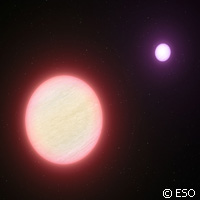Brown dwarfs? A cool cup of tea
Researchers from Canada, France and the US have discovered that the dimmest and coldest star in space is as hot as a cup of freshly brewed tea. Presented in the upcoming Astrophysical Journal, the findings show that the brown star in a double system is about as large as Jupiter. But the surface temperature of the smaller, farther star is 100 oC. While the temperature is hot for people, it is very cold for a star's surface. In effect, brown dwarfs are failed stars. Astronomers say the dwarfs do not have enough mass for gravity to generate the nuclear reactions that give stars their shine. Using the European Southern Observatory's Very Large Telescope (VLT) and two other telescopes - the Laser Guide Star (LGS) Adaptive Optics on the Keck II Telescope in the US state of Hawaii, and the Canada-France-Hawaii Telescope - the team identified the brown dwarf as CFBDSIR 1458+10B, the dimmer member of a binary brown dwarf system about 75 light years from Earth. They used the X-shooter spectrograph on the VLT to reveal that the composite object was very cool by brown dwarf standards. Until now, the coolest brown dwarf binary on record is CFBDSIR 1458+10. 'We were very excited to see that this object had such a low temperature, but we couldn't have guessed that it would turn out to be a double system and have an even more interesting, even colder component,' explains Philippe Delorme of the Institut de Planétologie et d'Astrophysique de Grenoble (CNRS/Université Joseph Fourier), one of the authors of the paper. 'At such temperatures we expect the brown dwarf to have properties that are different from previously known brown dwarfs and much closer to those of giant exoplanets - it could even have water clouds in its atmosphere,' says lead author Michael Liu of the University of Hawaii's Institute for Astronomy (US), who is lead author of the paper describing this new work. 'In fact, once we start taking images of gas-giant planets around Sun-like stars in the near future, I expect that many of them will look like CFBDSIR 1458+10B.' Astronomers continue to search for cool objects. Scientists recently used the Spitzer Space Telescope to identify two other very faint objects as potential contenders for the coolest known brown dwarfs. However, they could not precisely measure their temperatures. The team believes future observations will help researchers compare these objects to CFBDSIR 1458+10B. The scientists are looking to reassess CFBDSIR 1458+10B to better determine its properties and to begin mapping the binary's orbit, which, they say, after about a decade of monitoring should allow astronomers to determine the binary's mass.For more information, please visit:European Southern Observatory (ESO):http://www.eso.org/public/Astrophysical Journal:http://iopscience.iop.org/0004-637X
Countries
Canada, France, United States



